Jamaican Rice and Peas or Beans is the perfect paring for Jerk Chicken, or just as a side dish for many other meats to make up a meal. Since the combination of Rice & Beans creates a whole protein dish, It’s even good all by itself with Jerk Ketchup drizzled over top. Maybe with a side of Johnny Cakes too.
There are many versions of this dish, with all kinds of seasonings added. Everything can be adjusted to taste and even additional ingredients added in. This recipe covers the more traditional way with the common Island ingredients. There is also another version I call Toasted Jamaican Rice & Peas or Beans made with the same ingredients, but the technique is different.
What is Jamaican Rice and Peas
Traditional Jamaican Rice & Peas is a Rice dish made with Long Grain Rice & Beans, either Kidney Beans or Pigeon Peas (Gungo), with Coconut Milk, Bean Water, the Jamaican Holy Trinity of Green Onions/Scallions, Garlic & Thyme, a whole Scotch Bonnet Pepper, with Salt & Pepper.
Some may include other ingredients such as Onion & Ginger, or even Salt Pork. Everything is cooked in the same pot, and makes a dish that is a complete protein all by itself. Most notably served with Jerk Chicken.

Jamaican Holy Trinity
The Jamaican Holy Trinity consist of Scallions/Green Onions, Garlic & Thyme. This combination serves as the flavoring used through many types of dishes. It is usually combined with a source of heat, such as Scotch Bonnet Peppers and Black Pepper.
These can be used in many forms, from whole, crushed, chopped or pureed. Green Onions are usually crushed and added whole with the root chopped off, Garlic added whole or crushed, and fresh Thyme Sprigs used for Rice & Peas. Although you can use dried or ground thyme just as well. In the Jamaican Jerk Chicken Marinade, more Green Onions & Thyme are included.

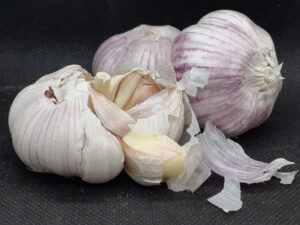
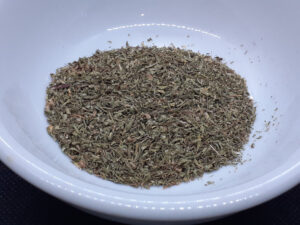
Complete Protein Meal
While both Rice & Beans are plant-based protein sources, they each lack certain essential amino acids. Rice is low in Lysine but high in Methionine, while Beans are high in Lysine but low in Methionine. When eaten together, they complement each other to provide all nine essential Amino Acids, making the combination a complete protein.
The beans added with rice also has an effect on reducing the glucose spike due to the protein and fiber which slows the absorption of glucose into the bloodstream.
This is why Rice & Beans are a staple in many cultures around the world. They always provide a nutritious, affordable, and balanced meal when consumed together. Plus, any Rice & Bean combination dish is going to be extremely filling for a long time, and is one of the cheapest sources of getting a complete protein meal.

The image above shows Jamaican Rice & Peas, served as a main course with Jerk Ketchup drizzled over top and a side of Johnny Cakes.
Jamaican Rice and Peas ingredients
Long Grain Rice, Red Kidney Beans or Pigeon Peas, Bean Water (crucial for the color), Coconut Milk, Fat, Allspice, Thyme, Scotch Bonnet Pepper, Green Onions, and Garlic, with Salt & Black Pepper.
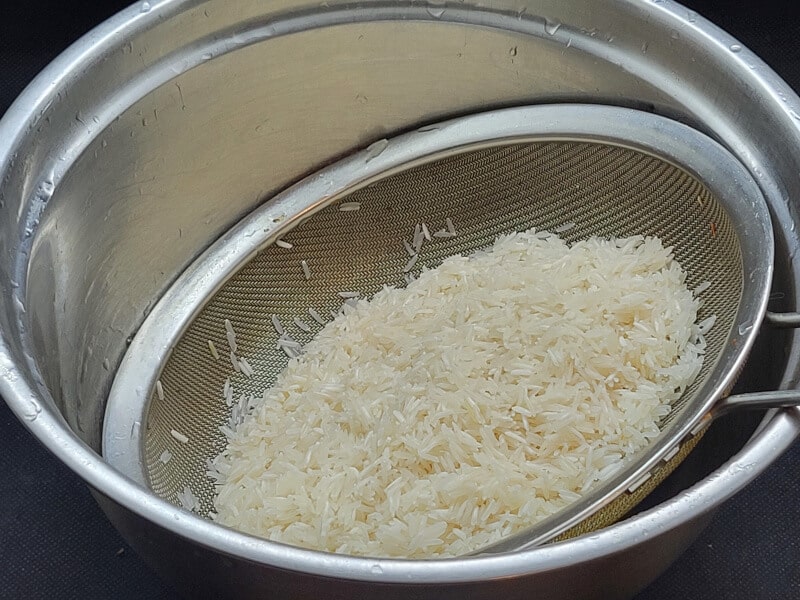
Long Grain Rice
Use a Long Grain Rice, like American White or Jasmine, Basmati can also be used. Wash well and strain, leaving it over a bowl as you prepare to ensure the rice is completely dry, when ready to add.

Kidney Beans
Use Dried Red Kidney Beans soaked in salted water overnight. The same Salt to Water ratio used for Pasta is used for Beans. 4 Cups water to 1/2 Tbl Sea Salt for 1 Cup of dried kidney beans.

Bean Water
The Bean water from simmering dried Kidney Beans is crucial for added flavor and the color of Rice & Peas. You only need 1 Cup of it.
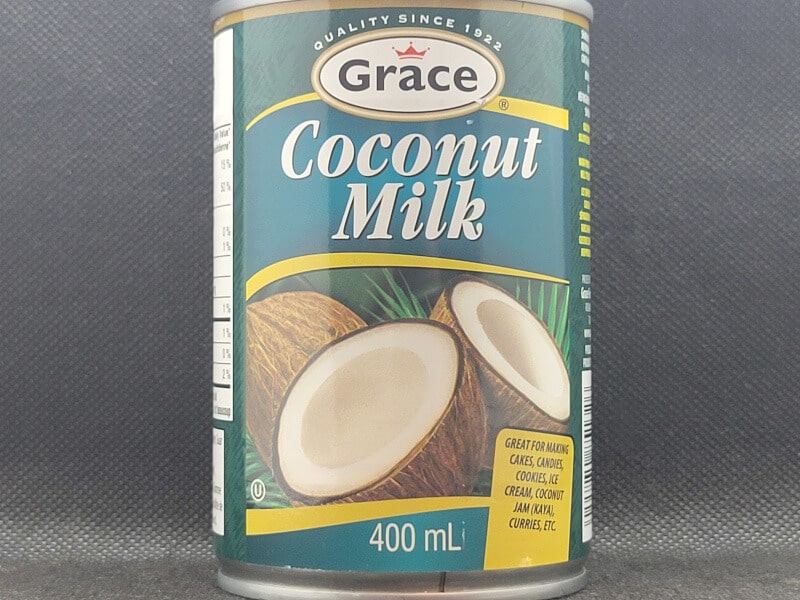
Coconut Milk
Thin Coconut Milk, not thick. This is traditionally made from a whole Coconut. You only need 2 cups or about 400 ml. This will be just shy of 2 Cups, top up with water. If the Coconut Milk is thick, dilute coconut milk with water to get 2 cups of a thin coconut milk.

Coconut Fat
I do like the addition of Coconut Fat and find starchy food items, such as both the Rice & Beans used in this recipe, are greatly enhanced with the addition of Fat. Substitute with Butter, Rendered Fat, Lard or Neutral Oil.
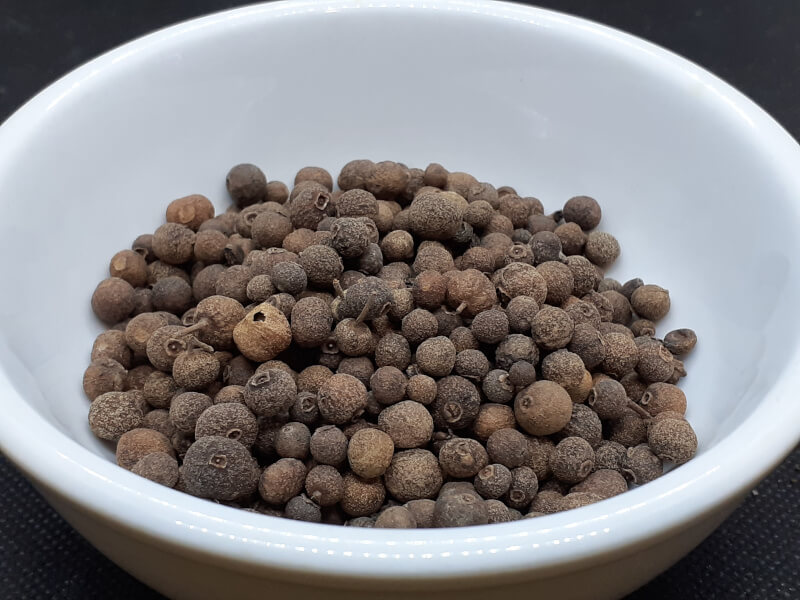
Allspice
Add in 8-13 whole Allspice Berries or more to taste. Although you will have to pick them out later. For this reason, I just use ground Allspice.

Thyme
Traditionally Fresh Thyme Sprigs are used, anywhere from 3-5 sprigs. Although 1 Tbl of dried Thyme can also be used or about 1 tsp of ground Thyme.

Scotch Bonnet Pepper
Green Scotch Bonnet Peppers are usually used. Red Scotch Bonnet can be used, but are typically used in places where a sweeter and more intense heat are desired. You are more often to see Green, Orange or Yellow Scotch Bonnets used in Rice dishes. The Scotch Bonnet Peppers are added whole and beacuse of this doesn’t really contribute heat. If more heat is desired, peirce the Pepper with a fork to release more heat.

Green Onions
Sometimes you see the Green Onions being added whole, chopped into large pieces, or crushed for adding to the Rice & Peas. Then removed before serving. You can also just chop the Green Onions to add and keep them in the dish, whichever you prefer.

Garlic
In some recipes, Garlic is added whole and then removed or just mixed in. You can also just mince and add it. Just the same as the Green Onions, whichever you prefer.
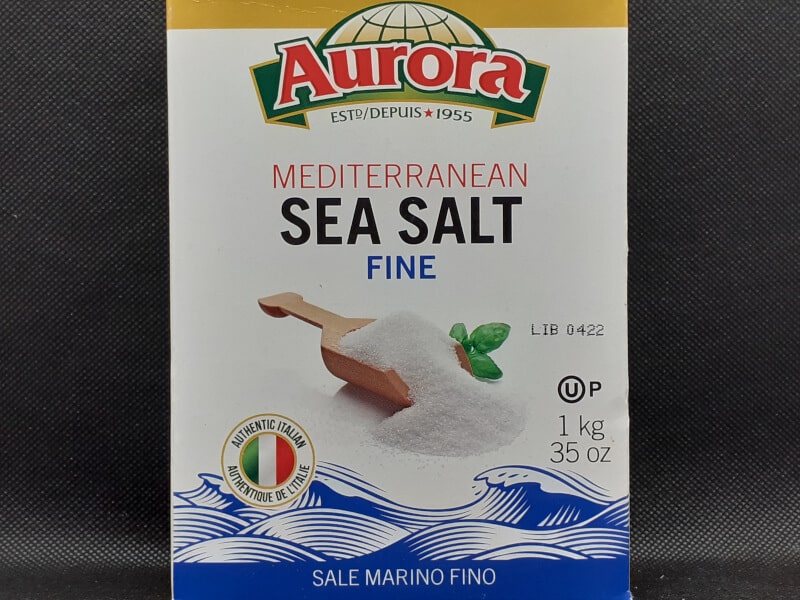
Sea Salt
Salt is crucial for well seasoned Beans and for seasoning the Rice. Additional Salt can be added to taste when fluffing the Rice if needed.

Black Pepper
While this recipe uses 1 tsp of Black Pepper. It still results in a Rice & Peas dish that is not really spicy at all, even with the Whole Scotch Bonnet. More Pepper can be added to taste, to adjust the seasoning before serving. Optionally pierce the Scotch bonnet pepper with a fork to add additional heat.
Long Grain Rice
Long Grain Rice is used, and often Jasmine Rice because of the scent added to the rice, that contributes to the Rice & Beans flavor. Other Long Grain Rice that can be used are American White Rice or Basmati. Wash the Rice well before adding to the pot last, you don’t want any excess water in the Rice at all. If toasting the Rice, then it doesn’t need to be washed and can go straight to the pot or deep pan with Fat to toast.

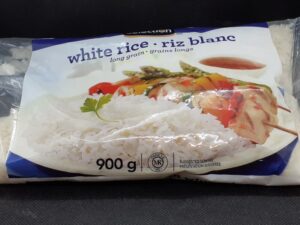
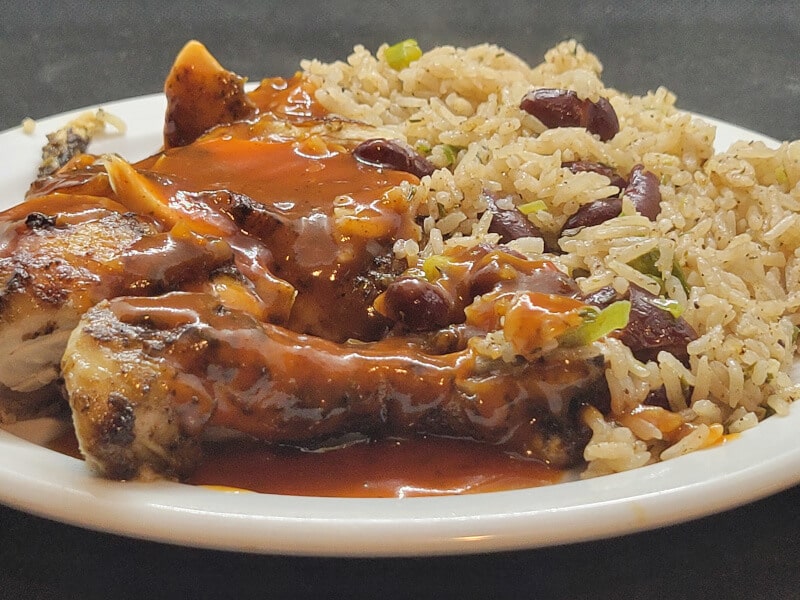
The above image was made with Jasmine Rice with some chopped Jerk Chicken & Jerk Ketchup.
Kidney Beans
Usually, dried Kidney Beans are soaked overnight and is a necessary step to let the beans absorb the water & salt to start softening and seasoning the Beans. It also shortens the cook time.
Only 1 Cup of dried Kidney Beans is used and soaked overnight in Salted water. The cook times for the Beans can vary depending on the age of the dried beans. Simmer for 1 hour or until softened to your liking. Check at about 30 minutes for softeness. You are looking for Soft & Creamy all the way through with no breaking of the skin and well seasoned.

Soaking Beans in Salt Water
Adding Salt to Beans while soaking them overnight is beneficial for a few reasons:
- Flavor: Soaking beans in salted water (bean brine) allows the beans to absorb some of the salt, enhancing their flavor from the inside out. There is a very big difference between beans soaked in just water or salted water.
- Improved Texture: Salt can help prevent the beans skins from bursting during cooking, leading to a more consistent texture. Salt also helps to break down the tough outer skin of the beans, making them more tender and evenly cooked.
- Reduced Cooking Time: A bean brine can slightly reduce the cooking time because the beans will have already begun to soften. Both from soaking overnight and from the salt. This is further enhanced with previously boiling the beans before resting overnight.
This method, of soaking beans in a bean brine is a simple and neccessary way to improve both the flavor and texture of the beans.
Bean Brine
A Bean Brine is made up of 4 Cups of Water with 1/2 Tbl of Sea Salt used for soaking 1 C Dried Beans overnight. Which convienently is the same for Pasta Water with its Water to Salt ratio. Just like Pasta, you want the Beans to be seasoned throughout.
Although I have made batches with 5 Cups of Water & 1 Tbl Sea Salt and these resulted in very well seasoned beans throughout, perhaps teetering on too much. But they were very good though, so good that you could just snack on the beans themselves. But this comes down to personal preference and taste. Start at the lower end and adjust for your taste. I just point it out because generally 1/2 Tbl of Sea Salt – 1 Tbl of Sea Salt to 4-5 Cups is your range.

Strain the Beans after soaking or not
It’s generally recommended to strain the beans after soaking and discard the soaking water. Although there are some additional benefits of simmering the beans in the same water they were soaking in overnight.
If you find you are the type to get bloated from Rice & Peas, then strain and rinse. If not, simmering the beans in the same bean brine they soaked in may offer better health advantages. The other noticeable effect in not straining the beans, will result in a darker color rice.
Reasons to Strain and Rinse Beans
- Reduced Gas and Digestive Issues: Soaking beans helps remove some of the indigestible sugars (oligosaccharides) that can cause gas and bloating. These sugars leach into the soaking water, so discarding the water can help reduce these effects.
- Cleaner Flavor: The soaking water can contain impurities and compounds that might impart a slightly off taste to the beans. By discarding it, you start with fresh water for cooking, which results in a cleaner flavor.
After soaking, rinse the beans thoroughly under cold water before cooking them in fresh water.
Reasons to simmer beans in the same soaking water
The indigestible sugars in beans, primarily oligosaccharides like raffinose and stachyose, are a type of prebiotic fiber. These sugars are not digested by the human body. But are instead fermented by bacteria in the large intestine, which can lead to gas production. However, they do have health benefits:
- Prebiotic Effect: These sugars serve as food for beneficial gut bacteria, promoting a healthy gut microbiome. A healthy gut microbiome is linked to better digestion, improved immune function, and even mental health benefits.
- Increased Satiety: The fermentation process can produce short-chain fatty acids, which are beneficial for gut health and can help you feel full longer.
- Blood Sugar Control: The slow digestion of beans, partly due to these indigestible sugars, can help regulate blood sugar levels by preventing rapid spikes.
So, while they may cause some digestive discomfort for some people, they do offer health benefits. If you find beans hard to digest, you can still reduce the oligosaccharides by soaking and rinsing them, or you can gradually increase your bean intake to help your body adapt.
Red Kidney Bean Toxicity
Red Kidney Beans have a high level of Lectin. This is significantly reduced by soaking the Beans for at least 8 hours and boiling. It is the duration the Beans are exposed to the heat that is significant in reducing the lectin content, mainly boiling hard for 10 minutes at the start.
Easy to Digest Beans
Soaking and simmering the Beans for a length of time also reduces the components that make Beans hard to digest, by more than 80%. This is further enhanced when soaking the beans overnight in salt water.
Coconut Milk
Traditional Jamaican Rice & Peas is made with fresh Coconut. The Coconut is shredded or blended with Coconut Water to make the Coconut Milk, with the pulp strained or squeezed out. Most opt to use a can of Coconut milk or about 2 cups of Coconut Milk. But using Fresh Coconut would derive far better flavors.
400 ml of Coconut milk is just shy of 2 Cups. With thick Coconut milk, dilute it with water and only use 2 cups worth of a thin coconut milk.

Traditional Jamaican Rice & Peas cook method
Traditional Jamaican Rice & Peas is cooked with everything done in one pot. First, the Beans are soaked overnight, some strain and rinse, others do not. The Beans are brought to a boil, before covering and reducing the heat to simmer the Beans until soft. Some may add all additional ingredients here, except for the Rice to simmer with the Beans, adding flavor. As well as salting the Beans during soaking, boiling or after the Beans have softened.
Once the Beans are softened, the remaining bean water is estimated by either cooking uncovered to reduce the water or adding more water if needed before all the other ingredients except the washed and strained Rice go in to simmer just briefly to meld the flavors, if this was not done previously while softening the Beans.
Lastly, the washed and strained Rice is added, mixed and topped with Garlic, Scallions, Fresh Thyme and a Scotch Bonnet Pepper to bring to a boil, if they were not added previously to the Beans. Once boiling, the cover goes on, the heat reduced to medium low and cooked for about 20 minutes. Afterwards, the heat is shut off, but the pot remains covered and on the burner for 10 minutes.
There are many different ways to make this, but in general Rice is added when the amount of Liquid seems right. If there is too much liquid it is reduced and if there is not enough, more water is added.

Jerk Rice & Peas
Some will add a bit of Walkerswoods Jerk Marinade as the seasoning for the Jamaican Rice & Peas with all of the other ingredients or instead of adding Thyme, Green Onions, Garlic, Scotch Bonnet, Allspice, Black Pepper, and Bay Leaf.
I often add the Homemade Jerk Chicken marinade in addition to all of the ingredients added for Rice & Peas, about 1-2 Tbl, whenever I am making Jerk Chicken.

Toasted Rice & Peas
The Toasted Rice & Peas is prepared differently from the Classic Jamaican Sunday meal. While the Ingredients are the same, the preparation is different, because of the following reasons.
- The Rice is toasted in Fat for a total of 10 minutes over medium heat until the color changes to a Toasted Brown color. This gives the rice a Nutty Flavor and cooks out the Starch, no need to wash the Rice.
- The boiled & strained Beans are added so they can hit the Hot Oil which enhances the flavor and texture of the Beans.
- The last reason is for fine control over the amount of liquids added. Being measured in your liquids will ensure you create Jamaican Rice & Peas that are perfectly cooked to the bite and not overly mushy. Instead the rice will have a nice plumpness, and easily flow everytime. Even for the Traditional way of cooking Rice & Peas, I will strain out the bean water and only add in what I need.
How to make Toasted Jamaican Rice and Peas

Kidney Beans
Place 1 Cup of Kidney Beans into a Pot with 4 Cups of Water & 1/2 Tbl of Sea Salt. Leave to soak overnight.
The next day, bring the pot of beans to a boil, keep boiling for 10 minutes. Reduce the heat just a tad below medium and cover to simmer for about 30 minutes, or until the beans are done, mixing every so often. The Kidney Beans should be soft and creamy all the way through. Well seasoned and no splitting of the skin. Strain out and reserve 1 Cup of Bean Brine.
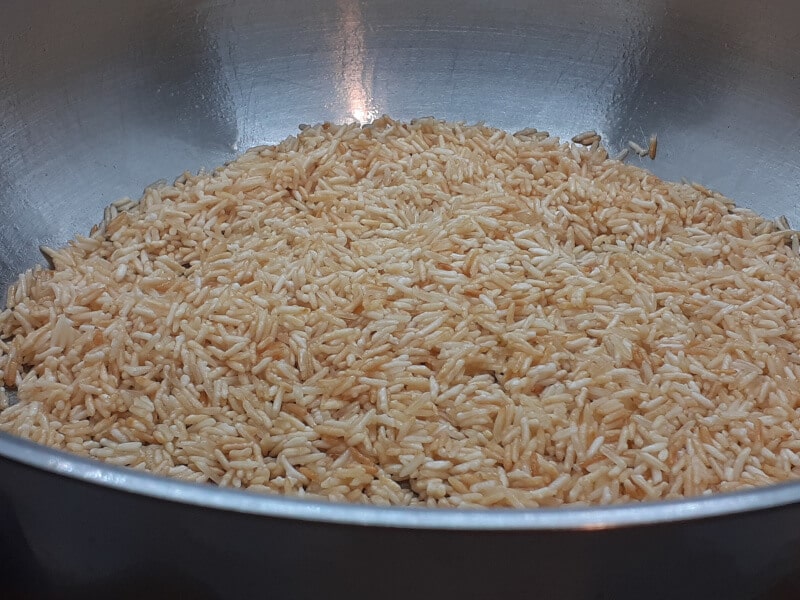
Toasted Rice
Place Coconut Fat into the Pan over medium heat and add the unwashed Rice to toast for about 5-7 minutes. Mix frequently for even browning.

Remaining Ingredients
Add the cooked Kidney Beans to toast and mix often for about 3-5 minutes. Add the liquids and remaining ingredients, top with Green Onions, Garlic, and Scotch Bonnet Pepper, then Bring to a boil, if not already.
Optionally pierce the scotch bonnet with a fork for more heat.

Cook Low
Once the Rice & Peas are boiling, cover the pot and reduce the heat to medium low, closer to low and leave for 20 minutes. After 20 minutes, shut the heat off, but leave it on the burner while still covered for an additional 10 minutes before fluffing and serving.
Rice to Liquid Ratio
I know in Jamaican homes, all of this is eyeballed. The main reason for that is because all the ingredients are added in except for the Rice to flavor the Beans as they soften. Rice is added last, but if you are not measured you can end up with mushy Rice & Peas, because of too much liquid.
I prefer to be very percise. Because it doesn’t take too much liquid one way or the other to throw the Rice off. Resulting in not enough Liquids or too Mushy of a Rice. Just as much as 1/2 C of Liquid either way will throw it off. The type of Rice as well will indicate whether the ratio of Rice to Liquid needs to be increased or decresed.
In general 1 C Rice to 1 1/2 C Liquids is good. With further adjustments in reducing or increasing the liquid amounts to yeild a Rice that is free flowing, plump with bite, depending on the type of Rice or brand being used. This of course means to fine tune the Rice perfectly, you need to make it at least once. At higher altitudes you may need to use more liquids, due to the lower boiling point of water.
How to adjust Jamaican Rice and Peas Rice to Liquid Ratios
While typically you adjust the amount of Liquids up or down when cooking up a certain rice dish. With Jamican Rice & Peas, it is recommended to keep the Liquids the same and increase or decrease the amount of Rice being used. In Jamaican homes where this is prepared so often, this is eyeballed on how much liquid is needed and more liquid is added or the liquids simmered down until it looks right, before adding in the Rice.
For me, the ratio of Bean Water to Coconut milk is most ideal and so in order to adjust for firmer Rice, I add more Rice instead of reducing the liquids. This of course means that the dish has to be made at least once before making the adjustment the next time to produce better results.
If you find the Rice came out a bit softer than deired, increase the Rice by 1/4 C. On the opposite spectrum, if the Rice came out too firm or dry, decrease the Rice by 1/4 C. Although this is rare, actually I never had to decrease the Rice. Increasing the Rice is much more common and is needed depending on the type of Rice or Brand.
Jamaican Rice & Peas additions
Often Jamaican Rice & Peas will include a variety of things added. Most commonly Ginger & Jerk Chicken Marinade. Another common addition is 1 Chicken Bouillon Cube, especially when served with Chicken as the main course.

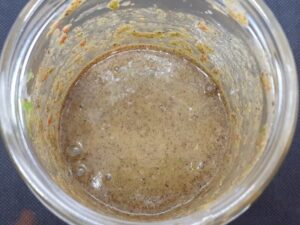
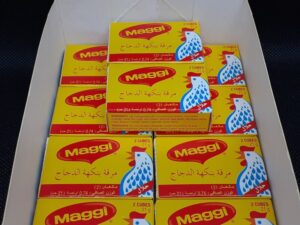
Jamaican Rice & Peas Adjustments
Jamaican Rice and Peas are suppose to be with well seasoned beans that are creamy all the way through. With free flowing, plump rice that is neither too dry or to wet (mushy). The exterior of the rice is intact and has bite.
Some adjustments may be necessary. Mainly the Liquid to Rice Ratio with salt added to season the Rice & Brined Beans. The amount of heat the Rice is cooked at is a medium low, closer to low. Although this will vary slightly and you may need to make adjustments to cook the Rice a little more towards medium or more towards low. If a Bun Bun is desired, then more so towards medium, but not at medium, this is too high. The Bun Bun is the crispy bits of rice at the bottom of the pan and is often sought for. In Jamaica this is called Bun Bun.
The Salt & Pepper content is another variable you may want to adjust. The Bean brine is made up of 4 Cups of water with 1/2 Tbl of Sea Salt for decently seasoned Beans. 1 Cup of the Bean water is then further diluted with 2 cups or 400 ml of Coconut Milk. More Salt is added to season the Rice and more Salt & Pepper may be added at the end to adjust the seasoning and lift the flavors more while fluffing the Rice. Adjust as you see fit.
Quick Jamaican Rice & Peas
For a quick versionof Jamaican Rice & Peas, use a can of Kidney Beans that are strained and rinsed. Throw everything into the pot, except the washed & dried Rice to come to a boil. Once boiling, add the Rice to mix through. Cover and reduce the heat heat to medium low to cook for 20 minutes. Shut the heat off and leave on the burner for an additional 10 minutes, before you fluff the Rice and adjust the seaosning.
Jamaican Rice & Peas with Jerk Chicken
Serve this JAHMAICAN Rice & Peas with some JAHMAICAN Jerk Chicken and that crazy good sauce drizzled all over. Add some Hot Sauce too for some heat, maybe a side of Johnny Cakes or buttered Bread.

Equipment
- 1 Pot with lid
- 2 Bowls
Ingredients
- 2 C Long Grain White Rice - American, Jasmine or Basmati, washed and strained if not toasting it
- 400 ml Coconut Milk - or just shy of 2 cups
- 1 C Bean Brine - from boiling the beans
- 1/4 C Coconut Fat - See notes
- 3-5 Stalks Green Onions - washed and chopped, or crushed or left whole
- 3 Cloves Garlic - minced or left whole
- 1 Whole Scotch Bonnet - or Habanero Pepper. washed left whole or for spicy pierced with a fork
- 2 tsp Sea Salt
- 1 tsp Ground Allspice & Thyme - each, ground or 8-13+ Allspice Berries & 1 Tbl Dried Thyme/ 3-5 sprigs of Fresh Thyme
- 1 tsp Black Pepper
- 1/4 tsp Ground Bay Leaves - or 2 Bay Leaves
Bean Brine
- 4 C Water
- 1 C Dried Kidney Beans - or Pigeon/Gungo Beans
- 1/2 Tbl Sea Salt
Instructions
- Add dried Kidney Beans or Pigeon Peas into a pot with 4 Cups of Water & 1/2 Tbl Sea Salt and leave to rest overnight. Either strain and rinse the beans off to place back into the pot with another 4 Cups of water only. Or transfer the Beans directly to the stove to cook in the same water and salt you used to soak the Beans.
- Place the pot of beans on the burner over max heat. Bring to a boil over max heat and hard-boil for 10 minutes. Drop the heat just below med, cover, and simmer for 30 minutes, or until the beans are softened to your liking. Mix every once in a while. Check at 30 minutes, and simmer longer if needed. The beans should be soft and creamy with no breaking of the skin and well seasoned.
- At the same time, wash the Rice until the water runs clear and strain until ready to add to the pot. When the beans are ready, strain and reserve the Bean Water. Add the Beans back into the Pot along with 1 Cup of reserved Bean Water and the remaining ingredients, except the Rice, and bring to a boil over max heat.
- Add the washed and dried Rice and mix. Bring to a boil, cover and reduce the heat to medium low, closer to low, for 20 minutes. Optionally closer to medium for Bun Bun (Crispy bits of rice at the bottom of the pot). After 20 minutes, shut the heat off but leave the pot on the burner still covered for an additional 10 minutes. Remove the large food items. Adjust the seasoning if needed while fluffing the Rice before serving.
Notes
Toasted Rice & Peas
- Soak the beans overnight in a bean brine and simmer them until soft. Strain out and reserve 1 Cup of the Bean Water.
- Heat a pan over medium heat with a high smoke point Fat and add the rice to toast for 5–7 minutes.
- Add the softened strained beans to toast for about 3–5 minutes.
- Add the Liquids and remaining ingredients to mix and bring to a Boil.
- Cover and reduce the heat to medium low, closer to low, for 20 minutes.
- Shut the heat off, but leave the Rice while still covered on the burner for 10 minutes.
- Uncover, taste and adjust while fluffing the rice before serving.

